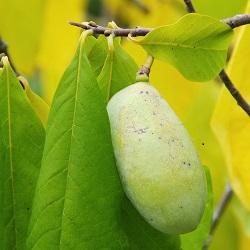
|
Also known as the Poor Man's Banana or Hoosier Banana. Indigenous to the United States. A deciduous, often narrow conical tree growing 12 to 25 feet in height and less broad. This pyramidal shaped tree has dense, dangling foliage giving the Paw Paw an interesting tropical appearance.
The dark green leaves grow up to 12 inches in length. In March to May they produce maroon, upside down flowers that measure up to 2 inches across. The large edible fruit is produced, often in clusters from the blooms. The Paw Paw is an oblong shaped fruit, light green in color, weighing 5 to 16 ounces and is 3 to 6 inches in length. The fruit has a high amount of protein, minerals, amino acids and antioxidants. The inside has a creamy, custard texture, varing in color from creamy-white to yellow-orange. Its taste is described as a cross between a mango and a banana. The 10-14, brownish to black seeds are arranged in two rows and shaped like lima beans, with a length of 1/2 to 1 1/2 inches long. Harvest time mid August to mid October. Should produce fruit in 5 to 6 years.
Grows best in full sun once established. Plant in deep, fertile soil that is well drained and slightly acidic. Deer and rabbit resistant. Wildlife food for foxes, raccoons and squirrels. Bees show no interest in Paw Paw flowers. Relatively disease free.
Plant at least two trees for fruit production to ensure cross-pollination. Be the first to grow the largest edible native fruit in America.
Zone: 5-8
Height: 12-25 Ft.
Spread: 10-15 Ft.
Restrictions:
Prohibit Potted: AL,AK,AZ,AR,CA,CO,HI,ID,KS,MS,MT,NE,NV,NM,ND,OK,OR,PR,SD,TX,UT,WA AND BRITISH COLUMBIA
|